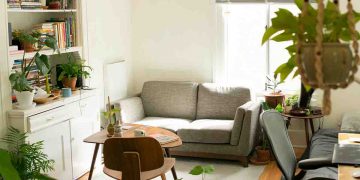
Biophilia: The Design Trend That Blurs the Inside and Out
In recent years, our homes have become everything to us. They are where we live, where we study, and oftentimes even where we work. They are our bubble. But sometimes that bubble needs a little sprucing up, a little context, a little bit of nature to make it feel as accommodating and connected as can be. Enter biophilia or, as it shows up in our homes, biophilic design.
I know what you’re thinking: Biophilia? What the heck is biophilia? It sounds like a disease. And I completely agree. Regardless of the name, the theories of both biophilia and biophilic design are sound ones with a lot of attractive qualities.
Named by biologist Edward O. Wilson in the 1980s, biophilia is his philosophy that humans biologically want and need the natural world. Biophilic design, as it follows, is a concept that involves bringing nature into indoors environments in ways but small and large. This includes natural light, outdoor views, vegetation and natural shapes and materials. Frank Lloyd Wright was a famous proponent of biophilic design, which was perhaps most evident in his design Fallingwater in the Laurel Highlands of Pennsylvania. Designed in 1935, Fallingwater is famously built over a waterfall, bringing the sounds, sights and smells of nature to its occupants at every turn.
While the principles of biophilic design aren’t new, the popularity of incorporating natural elements into our homes is growing – and with great reason. According to the EPA, the average person spends 90% of their time indoors. It stands to reason we want to feel more connected and grounded in the world, even if it’s from the security of our own homes. Keep reading for our more info on biophilic design, its connection to health, and how to add and enhance natural elements in your home, office or anywhere else you spend a lot of time indoors. (Hint: one potted plant is not going to do it.) If Wilson is correct, and we are biologically programmed to want to be in nature, you may find yourself feeling more content. And if not? Your place will still look great.
The Connection Between Biophilia, Design and Health

One of the best aspects of bibliophilic design is not what it can do for your home, but what it can do for your mental and emotional health. It makes sense. Think of the relaxing effect that listening to the sounds of the surf, breathing deeply after a rainstorm or feeling rays of warm sunshine on your face has on you. Bringing these good vibes into your home or anywhere else you spend a lot of time indoors is bound to have positive short- and long-term effects on everyone in your orbit – including your kids.
To that end, a 2019 study by the highly esteemed research institute Aarhus University in Denmark found that “children who grow up with greener surroundings have up to 55 percent less risk of developing various mental disorders.”
Additionally, a 2015 study also concluded that adding plants to indoor spaces reduced occupants’ stress levels and improved their pain tolerance. Studies have also shown that the availability of natural light or “day-lighting” to students and employees improves causes them to learn more, do better on tests, and be more productive.

Another great aspect of biophilia is that it doesn’t cost much to get the physical, psychological and emotional benefits of bringing more nature into your home, office and home office! You can easily get a biophilia design boost simply by diffusing essential oils, opening curtains and windows, and adding a ‘natural sounds’ playlist or white noise machine to your day to day. You can even put a pot of water with herbs, spices and oils on a low simmer on your stove to infuse your space with delightful smells straight from Mother Nature.
And remember all those pots, planters and gardening supplies you packed away in your CubeSmart self-storage unit? Time to pull them out of storage! Add a little fill dirt and fertilizer and some easily cared for houseplants, and bada bing: you’ve got indoors foliage ready to do battle for your air quality and sense of mental well-being.
5 Cheap and Easy Ways to Add Biophilic Design Elements to Your Home
So far, we’ve covered a few different suggestions about how to incorporate biophilic design elements into your home: plants, light, sounds, smells, etc. But there are other ways to add the look to your home that are just as cheap and easy – and will definitely pack a bit more biophilia into your day to day.
- Try a botanical statement wallpaper. Many retailers sell both permanent and “peel and stick” wallpapers with palm leaves, flowers, vines and animals. If wallpaper isn’t your thing, stencils, a can of paint and a sense of adventure can get you equally far. A great place to look for inspiration is Jungalow, the brainchild of Justina Blakeney, one of the most well-known and beloved biophilic design stars.
- Choose natural textures. Skip the plastic and polyester, and instead source sheets, bedding, blankets and rugs made from natural elements. Think jute, bamboo, wool, hemp, cotton, and linen. They’ll not only be of a higher quality than their synthetic counterparts, but they’ll give you a subconscious connection to nature every time you cozy up.
- Rearrange your furniture. Got a large window, skylight, glass door or any other source of light? Try rearranging your furniture to face it, or at least get as close as possible. Keeping an eye on a natural space or green area can have many positive benefits, but if that’s not available, the light alone will certainly boost your mood and might ward off seasonal depression. Just don’t forget your sunblock.
- Take advantage of any outdoor space. Of course, if you’re one of the lucky folks that has a balcony, patio, porch, backyard or any other outdoor space, you’re going to want to spend as much time as possible there. And don’t forget Whiskers and Fido! They benefit from nature as well. Check out our recent piece on building a catio or dog patio for some awesome techniques to get your four-legged friends into the fresh air.
- Add a water feature. As Frank Lloyd Wright would tell you, the sounds of running water are a key element of biophilic design. Consider adding a water element to your home to calm and center you with soothing, natural sounds. Check out Youtube for some interesting DIY indoor fountain ideas or buy a small version at any big box home improvement or gardening store.

A few other ideas include adding a windowsill herb garden, getting a fish tank or birdfeeder, and taking a hint from the Danish hygge habit of burning candles and adding a few “fire elements” to your home.
As far as home design goes, biophilia is here to stay – and perhaps, never left in the first place. Given the popularity of urban environments and electronic devices, it should come as no surprise how disconnected humans are becoming from nature. But the primal, biological need to connect with the environment around us remains.
If you can’t get out in nature as often as you’d like, get into nature in your own living space. Chances are small changes will have a big impact on your state of mind, not to mention air quality and Vitamin D levels.







